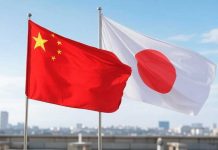From Gao Jiawei
Amidst Laos’ rugged mountainous landscapes, a daily spectacle unfolds as dozens of trains race through, carrying a diverse array of goods, from electronics to cold-chain fruits, bound for destinations in China, Thailand, Myanmar, Malaysia, and beyond. For the people of Laos who had endured the impact of dire transportation for decades, however, these sights have lost their novelty.
Two years have passed since China completed the construction of the China-Laos Railway, which connects the Chinese city of Kunming with Vientiane, the capital of Laos, a route that traverses mountains bearing the scars of unexploded American bombs from the Vietnam War. In this short span, over 19 million passengers and 24 million tons of goods have been transported, and more than 100,000 jobs have been created.
The once treacherous day-long drive from Vientiane to the Chinese border has transformed into a safe and smooth 3.5-hour journey. Today, with an average of seven passenger trains operating daily in Laos’ section, individuals sometimes still struggle for securing a ticket, given that Laos just added another passenger train set to its fleet from China in June. The ample demand for the rail service has surpassed initial expectations.
Over the past decade, hundreds of railroads and highways like the China-Laos Railway have been constructed from scratch over the most dangerous mountainous terrains and deserts across the Eurasian and African continents. Since the Belt and Road Initiative was proposed in 2013, promoting greater infrastructure connectivity and facilitating cross-border transportation with the aim to strengthen business and cultural exchanges have become a defining aspect of China’s international cooperation. Millions benefit from BRI projects. According to the World Bank, BRI is able to boost trade flows among participating countries by 4.1 percent, cut the cost of global trade by 1.1 percent to 2.2 percent, grow the GDP of East Asian and Pacific developing countries by an average of 2.6 to 3.9 percent, and lift 7.6 million people from extreme poverty.
(Source: https://www.worldbank.org/en/topic/regional-integration/brief/belt-and-road-initiative
A trap?
On the global stage, however, China’s overseas infrastructure projects under the BRI have faced significant scrutiny, often being depicted as costly plans that may push participating countries into a “debt trap.” The Bar-Boljare highway is on top of the list. It is the first highway in Montenegro history that connects the country from south to north, which is set to replace the old narrow two-lane expressway built along steep mountains and over deep canyons. Although Vatroslav Belan, former advisor to the Deputy Prime Minister of Montenegro on financial matters, stated in an interview that the project did not impose an excessive debt burden on his country, discussions still revolve around the cost of the highway.
China constructed the Bar-Boljare highway with a cost of around 20 million euros per kilometer, which seems like a high price at first glance. But here is a fair comparison to similar infrastructure projects, such as those in the Alps region. According to World Highways, Germany and Austria, two countries situated along the Alps, spent an average of 28.9 million Euros and 27.8 million euros per kilometer on their highways. Given that the Bar-Boljare highway includes the construction of 16 tunnels and 20 bridges over one of the toughest mountainous terrains in Europe, its cost falls within a more than reasonable range.
Since the BRI was proposed, it has never been a political tool setting traps for other countries, nor an empty slogan. Instead, it means concrete actions prioritizing gains for the sake of mutual prosperity.
Open for all
The original purpose of BRI was building an “economic belt” along the ancient “silk road” linking China with Europe. Despite this, the BRI does not impose geographical restrictions on participating countries, nor is it limited to developing nations. In fact, among the over 150 countries that have signed up for the Initiative, approximately half of them are categorized as upper-middle or high-income by the World Bank. Examples include countries like Hungary, New Zealand, Poland, and many others.
(Source: https://greenfdc.org/countries-of-the-belt-and-road-initiative-bri/)
Several Western corporations have already reaped benefits from the BRI. General Electric secured orders worth $2.3 billion for construction and engineering projects under the BRI, while Siemens collaborated with over 100 Chinese partners on BRI-related energy and mining projects. Citibank and Deutsche Bank have also participated in financing BRI projects. From China’s perspective, the BRI is an inclusive platform open to all stakeholders willing to engage.
Also, China welcomes other similar initiatives aimed at promoting cooperation and shared prosperity. The G7’s ‘Build Back Better World’ and the EU’s ‘Global Gateway’ can be promising endeavors, provided that their leaders prioritize meaningful actions over branding and abandon intention of competing with the BRI.
Cooperation rather than aid
To achieve prosperity, economies not only need modern infrastructure, such as high-quality electricity, fast rail, 5G networks and so forth, but, more importantly, a development path tailored to each country’s unique circumstances.
African countries have been receiving aid for decades. Prior to 2000, developed countries extended one trillion US dollars in aid to Africa, averaging 1,250 US dollars per person for its 800 million population at that time. Surprisingly, despite the peak of European and American aid between 1970 and 1998, Africa’s poverty rate soared from 11% to 66%.
(Source: Dead Aid: Why Aid Is Not Working and How There Is a Better Way for Africa by Dambisa Moyo)
China has actively supported Africa since the 1950s, albeit with a distinct approach. The wisdom of the proverb, “Give a man a fish, and you feed him for a day; teach a man to fish, and you feed him for a lifetime,” exactly characterizes China’s intentions in Africa and other developing nations under the BRI. China’s own economic ascent over recent decades underscores the belief that each nation should chart its development path based on its unique circumstances—harnessing its resources and fostering distinctive industries. The wiser approach lies in dismantling barriers to enable the smooth flow of essential factors for industrialization.
Instead of extending direct financial aid, China focuses on addressing crucial development needs, removing obstacles, and promoting trade, which are pivotal for African countries in breaking free from the control of aid providers and achieving self-reliance in development. The 1,860-kilometer-long Tazara Railway, linking Zambia to the Indian Ocean, has significantly bolstered the development of nations along its route, underscoring the effectiveness of China’s philosophy of assisting others in helping themselves.
Underlying this philosophy, the Belt and Road Initiative goes beyond merely offering financial assistance to impoverished nations. It revolves around empowering countries to foster their own development in which China gets market access, while BRI participants acquire technology and opportunities. It’s a mutually beneficial, two-way journey with cooperation at its core.
In the past decade, the BRI has undergone significant evolution. It has not only become more environmentally friendly, with an increasing emphasis on greenfield investments, but also smarter, as it promotes industries like telecommunications and cloud computing. As BRI cooperation broadens and deepens, it is reasonable to anticipate that it will persistently generate tangible benefits and foster growth for its participants and the global community in the years to come.
Gao Jiawei is a journalist with China Global Television Network (CGTN).





